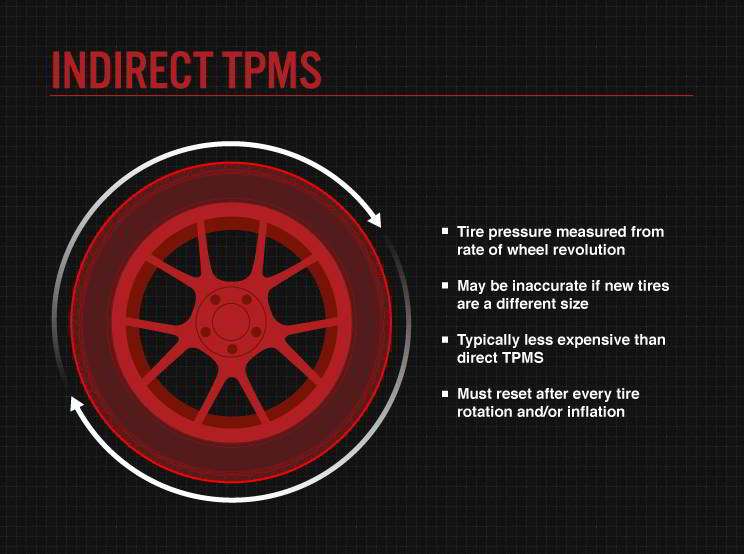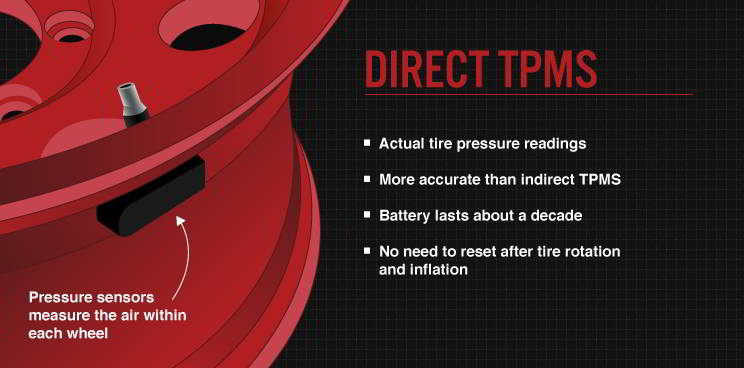Tire Pressure Monitoring Systems (TPMS)
Buy quality original equipment and replacement tire pressure monitoring systems at best prices online.
Tire pressure monitoring system (TPMS) is an electronic system designed to monitor the air pressure inside the tires, reporting real-time tire-pressure information to the driver via onboard computer. Newer cars come equipped with tire pressure monitoring system, but you can install an aftermarket TPMS as well.
To confirm if your vehicle has TPMS, turn on the ignition without starting the engine. If a tire icon with an exclamation sign lights up on the dashboard, vehicle is equipped with TPMS. You can also check the vehicle owner's manual for more information.
If vehicle's recommended tire pressure drops by 25 percent or more, tire pressure monitoring system will illuminate a dashboard warning light - a yellow exclamation mark inside a tire cross-section. If low tire pressure warning light is on, check tire pressure and inspect tires for punctures.
Purpose of the tire pressure monitoring system is to identify low tire pressure, warn driver to take action and keep tires properly inflated at all times to increase fuel efficiency, extend tire life, and ensure safety, stability and comfort when driving.
Tire pressure monitoring system (TPMS) low tire pressure indicator is a tire-shaped symbol with an exclamation point in the middle that illuminates on the dashboard instrument panel when tire pressure is low in one or more tires.
If low tire pressure light is on it means one or more of your tires are underinflated. Make sure to check tire pressure in all tires and adjust tire inflation to recommended levels until the warning sign is off.
If low tire pressure light is going on and off, it means tire pressure is near the recommended levels which trigger an alert. This can be caused by fluctuating temperatures. Check air pressure in all tires and add air to any tire that is underinflated.
If low tire pressure light flashes for about 60 to 90 seconds every time you start the car and remains illuminated it means the tire pressure monitoring system is not functioning properly and you should take it to an automotive service center for an inspection.
If vehicle is equipped with tire pressure monitoring system make sure to equip both sets of seasonal tires and rims with TPMS hardware. If you buy new winter tires with wheels, you will need to equip them with TPMS sensors, and you might need to reset the tire pressure monitoring system.
There are two types of tire pressure monitoring systems - direct TPMS and indirect TPMS.
An indirect tire pressure monitoring system does not use physical pressure sensors. It relies on wheel speed sensors used by the anti-lock brake system to measure the rate of revolution each wheel is making. Based on the rate of revolution of each wheel, computer systems can compare tire data and determine if any tire is spinning faster than expected, meaning it is underinflated.
Indirect tire pressure monitoring system does not actually measure tire pressure, it just alerts to changes in tire revolutions that may be cause by low tire inflation.

Direct tire pressure monitoring system uses pressure monitoring sensors installed within each tire that monitor their actual air pressure levels. Each tire pressure sensor has a unique serial number, and transmits data for each individual tire directly to the dashboard wirelessly.
This makes direct TPMS more reliable and accurate than indirect TPMS.

Both tire pressure monitoring systems serve the same purpose in helping driver identify low tire pressure.
